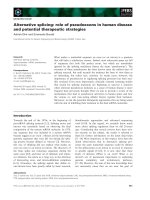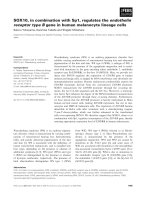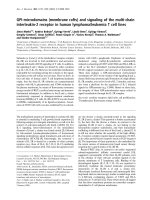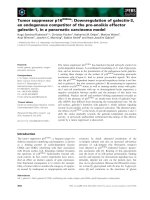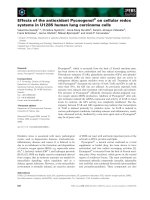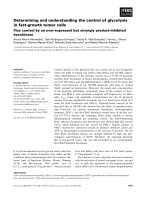Studies of the anti cancer potential of flavonoids in human nasopharyngeal carcinoma cells
Bạn đang xem bản rút gọn của tài liệu. Xem và tải ngay bản đầy đủ của tài liệu tại đây (4.63 MB, 194 trang )
STUDIES OF THE ANTI-CANCER POTENTIAL OF FLAVONOIDS IN
HUMAN NASOPHARYNGEAL CARCINOMA CELLS
ONG CHYE SUN
(Master of Science, National University of Singapore, Singapore)
A THESIS SUBMITTED FOR
THE DEGREE OF DOCTOR OF PHILOSOPHY
DEPARTMENT OF EPIDEMIOLOGY AND PUBLIC HEALTH
NATIONAL UNIVERSITY OF SINGAPORE
2010
Page | ii
ACKNOWLEDGEMENTS
I would like to express my deepest respect and heartfelt thank you to my
supervisor, Associate Professor Shen Han-Ming for his professional and tireless
guidance, as well as his patience, understanding and technical discussion
throughout my study. I would also like to express my thanks and
acknowledgement to my co-supervisor, Professor Ong Choon Nam for his
encouragement and patience. Their guidance and moral support have helped me
through this long journey without which I would never be able to complete.
I am blessed to work with a group of wonderful people in the laboratory who have
given me much help and moral support. I would like to take this opportunity to
express my thanks and gratitude to my dearest friend, Dr Zhou Jing for her
endless and selfless support; technical help, moral support and constant
encouragement. To my lab friends, Dr Huang Qing, Dr Lu Guodong, Dr Chen
Bo, Dr Wu Youtong, Ms Tan Huiling, Ms Ng Shukie and Mr Tan Shi Hao for
their care and concern; and the endless encouragement. Thanks, folks. I will
never get to where I am without all of you.
To my friends at the Singapore Polytechnic, I will forever be grateful to all of you
for covering some of my duties, dropping by the lab to give me word of
encouragements and the countless free lunches and tea to motivate me to hang on
and to seek the pot of gold at the end of the rainbow.
Last but not least, my deepest appreciation to my husband and three children for
their love, understanding and continuing support without which this learning
journey would be meaningless.
Page | iii
TABLE OF CONTENTS
Title Page
Acknowledgements ii
Table of Contents iii
Summary vi
List of Figures ix
Abbreviations xii
List of Publications xviii
Chapter 1: Literature Review 1
1.1 Cancer 2
1.1.1 Introduction 2
1.1.2 Cancer initiation and progression 3
1.1.3 Alterations in cancer genomes and signal transduction 5
1.2 Nasopharyngeal carcinoma 7
1.3 Cell cycle 12
1.3.1 Cdks and their corresponding cyclins as the key regulators of the cell 13
cycle
1.3.2 Substrates of cdks 16
1.3.2.1 Cdk substrates at the G1-S phase 17
1.3.2.2 Cdk substrates at the S phase 19
1.3.2.3 Cdk substrates at the M phase 20
1.3.3 Cdk inhibitors (CKIs) 21
1.3.3.1 The INK4 family of CKIs 21
1.3.3.2 The CIP/KIP family of CKIs 22
1.3.4 Cell cycle checkpoints 24
1.3.5 Deregulation of the cell cycle and cancer development 25
1.4 Apoptosis 29
1.4.1 Introduction 29
1.4.2 Morphological and biochemical features in apoptotic cells 29
1.4.3 Caspases 31
1.4.4 The extrinsic apoptotic pathway 32
1.4.5 The intrinsic (mitochondria-associated) pathway 36
1.5 PI3K-Akt pathway 42
1.5.1 Akt in cell survival 44
1.5.2 Akt in cell cycle progression and cell proliferation 46
1.5.3 The role of Akt in translational regulation 47
1.5.4 Activation of PI3K-Akt pathway and cancer development 47
1.6 Flavonoids 48
1.6.1 Introduction 48
Page | iv
1.6.2 Structures of flavonoids and their bioavailability 49
1.6.3 Anti-oxidant activity of flavonoids 51
1.6.4 Anti-oestrogenic (and oestrogenic) activity of flavonoids 52
1.6.5 Anti-tumour property of flavonoids 53
1.6.5.1 Effects of flavonoids on NF-B 53
1.6.5.2 Effects of flavonoids on cell cycle 54
1.6.5.3 Effects of flavonoids on Akt 56
1.6.5.4 Effects of flavonoids on tumour suppressor p53 57
1.6.5.5 Activation of apoptosis by flavonoids 57
1.7 Quercetin 58
1.8 Luteolin 60
1.9 Objective of this study 62
Chapter 2: Quercetin-induced growth inhibition and cell death in 64
nasopharyngeal carcinoma cells are associated with increase in
Bad and hypophosphorylated retinoblastoma expressions
2.1 Introduction 65
2.2 Materials and methods 67
2.2.1 Chemicals and reagents 67
2.2.2 Cell lines and cell culture 67
2.2.3 Proliferation assay 68
2.2.4 Cell cycle and apoptosis analysis assays 68
2.2.5 Protein extraction and western blot analysis 69
2.3 Results and discussion 69
2.3.1 Quercetin inhibits the growth of CNE2 and HK1 cells 69
2.3.2 Cell cycle arrest at G2/M and G0/G1 phases in quercetin treated CNE2 71
and HK1 cells
2.3.3 Induction of cell death via apoptosis and necrosis in quercetin treated 75
cells
2.4 Conclusions 82
Chapter 3: Luteolin induces G1 arrest in human nasopharyngeal carcinoma 84
cells via the Akt-GSK-3-cyclin D1 pathway
3.1 Introduction 85
3.2 Materials and methods 87
3.2.1 Chemicals and reagents 87
3.2.2 Cell culture and treatment 88
3.2.3 Cell cycle analysis 88
3.2.4 Apoptosis analysis 89
3.2.5 Immunoblot analysis 89
3.2.6 Immunoprecipitation of ubiquitinated enriched proteins 90
3.2.7 RT-PCR 90
3.2.8 Luciferase reporter gene assay 90
3.3 Results 91
3.3.1 Luteolin induces cell cycle arrest at G1 in a dose- and time- dependent 91
manner
3.3.2 Luteolin does not induce apoptosis in HK1 and CNE2 cells 95
Page | v
3.3.3 Luteolin induces cell cycle arrest at G1 phase by down-regulation of 98
cyclin D1 and subsequent suppression of E2F-1 transcriptional activity
3.3.4 Luteolin promotes phosphorylation and subsequent proteasomal 100
degradation of cyclin D1
3.3.5 Luteolin inhibits the Akt-GSK-3 signalling pathway upstream of cyclin 104
D1
3.4 Discussion 107
Chapter 4: Luteolin and quercetin sensitise NPC cells to the cytotoxic 110
effects of chemotherapeutics
4.1 Introduction 111
4.2 Materials and methods 114
4.2.1 Chemicals and reagents 114
4.2.2 Cell culture and treatment 115
4.2.3 Apoptosis analysis 115
4.2.4 Immunoblot analysis 115
4.2.5 Statistical analysis 116
4.3 Results 116
4.3.1 Luteolin sensitises CNE2 cells to the cytotoxic effect of VCR 116
4.3.2 Luteolin sensitises HK1 cells to the cytotoxic effect of VCR 121
4.3.3 zVAD-fmk abrogates the cytotoxic effect of luteolin and VCR on 124
CNE2 and HK1 cells
4.3.4 Quercetin sensitises HK1 cells to the cytotoxic effect of VCR and this 126
effect can be abrogated by zVAD-fmk
4.3.5 Sensitisation effect of flavonoids on VCR-induced cell death is 128
mediated by caspase-3-dependent apoptosis
4.4 Discussion 131
Chapter 5: General Discussion and Conclusions 133
5.1 Quercetin-induced growth inhibition and cell death in nasopharyngeal 134
carcinoma cells are associated with increase in Bad and
hypophosphorylated retinoblastoma expressions
5.2 Luteolin induces G1 arrest in human nasopharyngeal carcinoma cells 136
via the Akt-GSK-3-cyclin D1 pathway
5.3 Luteolin and quercetin sensitise NPC cells to the cytotoxic effect of 139
chemotherapeutics
5.4 Future studies 140
5.5 Conclusions 143
6 References 145
Page | vi
SUMMARY
Epidemiological studies have demonstrated that consumption of food rich
in fruits and vegetables results in low incidence of cancers. Although it is not
clear which components in fruits and vegetables are responsible for this
preventive anti-cancer property, evidence point towards the presence of fibres,
vitamins, minerals, polyphenols, terpences, alkaloids and phenolics in fruits and
vegetables as the contributing factors.
Flavonoids comprise the most common group of plant polyphenols and
provide much of the flavour and colour to fruits and vegetables. When consumed
in our daily life, flavonoids are able to provide beneficial effects like anti-
oxidative, anti-viral, anti-tumour and anti-inflammatory activities.
The molecular mechanism underlying the anti-tumour activity of
flavonoids has been extensively studied. However their effects on
nasopharyngeal carcinoma (NPC) cells are relatively less studied. Therefore, in
this study, we systematically investigated the anti-tumour property of two
common flavonoids namely luteolin and quercetin on two NPC cell lines, CNE2
and HK1 including (i) the effects of quercetin on cell growth inhibition and
apoptosis and (ii) the effects of luteolin on cell cycle arrest and (iii) the
sensitisation effect of luteolin and quercetin on apoptosis induced by cancer
chemotherapeutics.
We first identified the mechanism underlying quercetin-mediated cell
cycle arrest in NPC cells. Quercetin was able to inhibit the transcription factor
E2F-1 by keeping pRb in the hypophosphorylated form. E2F-1 is a transcription
factor controlling the expression of cyclin E, the cyclin requires for S phase
Page | vii
progression. In addition, quercetin was able to induce apoptosis in CNE2 and
HK1 by up-regulating the expression of Bad and Bax.
Next we investigated the molecular mechanisms underlying the cell cycle
arrest induced by luteolin in CNE2 and HK1 cells and our study demonstrated the
following: (i) Luteolin inhibited cell cycle progression at G1 phase and
prevented entry into S phase in a dose- and time-dependent manner; (ii) Luteolin
treatment led to down-regulation of cyclin D1 via enhanced protein
phosphorylation and proteasomal degradation, leading to reduced CDK4/6
activity and suppression of retinoblastoma protein (Rb) phosphorylation, and
subsequently inhibition of the transcription factor E2F-1. (iii) Lastly, luteolin was
capable of suppressing Akt phosphorylation and activation, resulting in de-
phosphorylation and activation of glycogen synthase kinase-3beta (GSK-3β).
Activated GSK-3β then targeted cyclin D1, causing phosphorylation of cyclin D1
at Thr
286
and subsequent proteasomal degradation. Since Akt is often over-
activated in many human cancers including NPC, it is thus believed that data from
this study support the potential application of luteolin as a chemotherapeutic or
chemopreventive agent in human cancer.
In the third part of this study, we examined the sensitisation effect of
quercetin and luteolin, both used at sub-cytotoxic concentrations on apoptosis
induced by vincristine, a commonly used cancer therapeutic agents, in both CNE2
and HK1 cells. Data from this part of our study thus provide experimental
evidence for potential application of combination therapy using these two
flavonoids.
Page | viii
In conclusion, the present study provides evidence to support the potential
application of flavonoids like luteolin and quercetin as chemopreventive or
chemotherapeutic agents.
Page | ix
LIST OF FIGURES
Fig 1.1: Overview of the molecular mechanisms involved in NPC development
Fig 1.2: The cell cycle and the respective control mechanisms
Fig 1.3: Molecular mechanisms controlling the activation of cdk1-cyclin B and
cdc25c at the onset of mitosis
Fig 1.4: Inhibition of pRb activity by cdk4/6-cyclin D and cdk2-cyclin E
phosphorylation
Fig 1.5: Domain organisation of caspases
Fig 1.6: The Fas signalling pathway
Fig 1.7: Cooperation between the extrinsic and intrinsic apoptotic pathway and
the negative regulation by ICAD-CAD complex
Fig 1.8: Model depicting the direct activation of Bax and Bak
Fig 1.9: Model depicting the indirect activation of Bax and Bak
Fig 1.10: Caspase activation by cytochrome c from a mitochondrion
Fig 1.11: The phosphoinositide 3-kinase-Akt signalling cascade
Fig 1.12: Basic structure of flavonoid
Fig 1.13: Chemical structures of the six major sub-classes of flavonoids
Fig 1.14: Induction of apoptosis by dietary flavonoids
Fig 1.15: Chemical structure of quercetin and its glycosides
Fig 1.16: Chemical structures of luteolin and its glycosides
Fig 2.1: Survival curves of quercetin treated CNE2 and HK1 cells
Fig 2.2: Cell analysis of quercetin treated and untreated CNE2 (A-D) and HK1
(E-H) cells
Fig 2.3: Quercetin up-regulates pRb and underphospho form of Rb in NPC cells
Page | x
Fig 2.4: Annexin V-FITC/PI double staining flow cytometric analysis of CNE2
cells
Fig 2.5: Annexin V-FITC/PI double staining flow cytometric analysis of HK1
cells
Fig 2.6A: Quercetin mediates apoptosis via the intrinsic mitochondrial signalling
pathway in CNE2 cells
Fig 2.6B: Quercetin mediates apoptosis via the intrinsic mitochondrial signalling
pathway in HK1 cells
Fig 3.1A & B: Luteolin induces cell cycle arrest at G1 in a dose- and time-
dependent manner in HK1 and CNE2 cells
Fig 3.1 C & D: Luteolin induces cell cycle arrest at G1 in a dose- and time-
dependent manner in HK1 and CNE2 cells
Fig 3.2: Luteolin fails to induce apoptosis in HK1 cells
Fig 3.3: Luteolin fails to induce apoptosis in CNE2 cells
Fig 3.4: Luteolin down-regulates cyclin D1 and suppresses Rb phosphorylation
and E2F-1 transcription activity in HK1 cells
Fig 3.5 A – C: Luteolin enhances cyclin D1 ubiquitination and proteasomal
degradation in HK1 cells
Fig 3.5D: Luteolin enhances cyclin D1 ubiquitination and proteasomal
degradation in HK1 cells
Fig 3.6: Luteolin suppresses Akt and GSK-3 phosphorylation in HK1 cells
Fig 3.7 A – C: Insulin and LiCl prevent down-regulation of cyclin D1 induced by
luteolin in HK1 cells
Fig 3.7D: Insulin and LiCl abrogate the effects of luteolin on CNE2 cells
Fig 4.1: Combined effect of luteolin (Lu) and chemotherapeutics on CNE2 cells
Fig 4.2: Combined effect of 10 M luteolin (Lu) and 2 nM VCR on CNE2 cells
for 48 h
Fig 4.3: Quantification of the combined cytotoxic effect of Lu and VCR on CNE2
cells
Fig 4.4: Combined effect of 10 M luteolin (Lu) and 2 nM VCR on HK1 cells for
(A) 24 h and (B) 48 h
Page | xi
Fig 4.5: Quantification of the combined cytotoxic effect of Lu and VCR on HK1
cells
Fig 4.6: Cytotoxic effect of Lu and VCR on CNE2 (A), and HK1 (B) cells could
be abrogated by zVAD-fmk
Fig 4.7: Combined effect of 5 M quercetin (Qu) and 2 nM VCR on HK1 cells
for 48 h
Fig 4.8: Cytotoxic effect of Qu and VCR on HK1 cells could be abrogated by
zVAD-fmk
Fig 4.9: The combined effects of either Lu or Qu with VCR led to an increase in
cleaved and active caspase-3 and PARP in CNE2 and HK1cells
Page | xii
LIST OF ABBREVIATIONS
7-AAD 7-amino-actinomycin D
AIF Apoptosis-inducing factor
AP-1 Activator protein-1
APC Adenomatous polyposis coli
APC/C Anaphase-promoting complex/cyclosome
Apaf-1 Apoptotic-activating factor-1
ATM Ataxia-telangiectasia-mutated
ATR Ataxia telangiectasia and Rad3 related
ATP Adenosine triphosphate
ATR Ataxia and rad3 related
Bcl-2 B-cell lymphoma-2
BH Bcl-2 homology
BIR Baculovirus IAP repeat
BrdU Bromodeoxyuridine
BRUCE BIR repeat-containing ubiquitin-conjugating enzyme
CAD Caspase-activator deoxyribonuclease
CAK Cdk-activating kinase
CARD Caspase recruitment domain
CDH1 CDC20 homologue 1
Cdks Cyclin-dependent kinases
CHX Cycloheximide
CKIs Cyclin-dependent kinase inhibitors
c-FLIP Cellular Fas-associated DD-like interleukin (IL)-1-converting
enzyme inhibitory protein
CREB Cyclic-AMP response element-binding protein
Page | xiii
COX-2 Cyclooxygenase-2
CP110 Centrosomal protein of 110 kDa
DD Death domain
DED Death effector domain
DHFR Dihydrofolate reductase
DIABLO Direct IAP protein-binding protein of low pI
DISC Death-inducing signalling complex
DMSO Dimethyl sulphoxide
DRs Death receptors
DTX Docetaxel
EBNA EBV-determined nuclear antigens
EBV Epstein-Barr virus
EDAR Ectodysplasin A receptor
EDTA Ethylenediaminetetraacetic acid
EGCG Epigallocatechin-2-gallate
EGFR Epidermal growth factor receptor
EGTA Ethylene glycol tetraacetic acid
ELISA Enzyme linked immunosorbent assay
Emil Early mitotic inhibitor
Endo G Endonuclease G
ERK Extracellular signal regulated kinase
FADD Fas-associating protein with death domain
FBS Foetal bovine serum
FITC Fluorescein isothiocyanate
FKHR Forkhead transcription factor
Page | xiv
5-FU 5-Fluorouracil
GLI Glioma-associated oncogene
GPCRs G protein-coupled receptors
GSK-3 Glycogen synthase kinase-3
HDAC Histone deacetylase
HEPES N-2-hydroxyethylpiperazine-N’-2-ethanesulfonic acid
HER2 Human epidermal growth factor receptor 2
HIF-1 Hypoxia-inducible transcription factor
HLA Human leucocyte antigen
IAP Inhibitor of apoptosis
ICAD Inhibitor of caspase-activator deoxyribonuclease
IGFR Insulin-like growth factor receptor
IKK Inhibitor of NF-B kinase
IMS Mitochondrial inter-membrane space
IP Immunoprecipitation
JNK Jun N-terminal kinase
LiCl Lithium chloride
LMP Latent membrane proteins
LPH Lactose phorizin hydrolase
Lu Luteolin
MADD Mitogen-activated kinase-activating death domain
MAPK Mitogen-activated protein kinase
MDR Multidrug resistance
MMP Metalloproteases
MOMP Mitochondrial outer membrane permeabilisation
Page | xv
mTOR Mammalian target of rapamycin
NaCl Sodium chloride
NF-B Nuclear factor-kappa B
NPA Nuclear protein mapped at the AT locus
NPC Nasopharyngeal carcinoma
NPM/B23 Nucleophosmin
OMM Outer mitochondrial membrane
ORC Origin recognition complex
PAGE Polyacrylamide gel electrophoresis
PARP Poly (ADP-ribose) polymerase
PCNA Proliferating cell nuclear antigen
PDK1/2 3-phosphoinositide-dependent protein kinase 1 / 2
PH Pleckstrin homology
PI Propidium iodide
PI3K Phosphoinositide 3-kinase
PIP
2
Phosphatidylinositol-4, 5-bisphosphate
PIP
3
Phosphatidylinositol-3, 4, 5-triphosphate
PKB Protein kinase B
Plk Polo-related kinase
PMSF Phenylmethanesulfonylfluoride
pRb Retinoblastoma
PS Phosphatidylserine
PTEN Phosphatase and tensin homolog
PTP Mitochondrial permeability transition pore
PTX Paclitaxel
Page | xvi
Qu Quercetin
PVDF Polyvinylidene difluoride
RAIDD RIP-associated ICH-1 homologous protein with a death domain
Rheb protein Ras homology enriched in brain protein
RIP Receptor interacting protein
RPMI Roswell Park Memorial Institute
ROS Reactive oxygen species
RTKs Receptor tyrosine kinases
RT-PCR Reverse transcriptase polymerase chain reaction
S6K S6 Kinase
SCF Skp, Cullin, F-box containing complex
SDS Sodium dodecyl sulphate
SMAC Second mitochondrial activator of caspases
STAT3 Signal transducer and activator of transcription 3
tBid Truncated Bid
TGF- Transforming growth factor-
TK Thymidine kinase
TNF Tumour necrosis factor
TNFR Tumour necrosis factor receptor
TRADD TNF-receptor associated death domain
TRAIL1 TNF-related apoptosis-inducing ligand 1
TRIS Tris(hydroxymethyl)aminomethane
TSC2 Tuberous sclerosis protein 2
VCR Vincristine
VGEF Vascular endothelial growth factor
Page | xvii
XIAP X-linked inhibitor of apoptosis
Page | xviii
LIST OF PUBLICATIONS
Ong CS, Zhou J, Ong CN, Shen HM (2010). Luteolin induces G1 arrest in
human nasopharyngeal carcinoma cells via the Akt-GSK-3-cyclin D1 pathway.
Cancer Letters 298; 167-75
Ong CS, Tran E, Nguyen TTT et al (2004). Quercetin-induced growth inhibition
and cell death in nasopharyngeal carcinoma cells are associated with increase in
Bad and hypophosphorylated retinoblastoma expressions. Oncology Reports 11;
727-33
Presentation at scientific conferences:
Ong CS, Zhou J, Ong CN, Shen HM. Involvement of the Akt-GSK-3-cyclin D1
pathway in luteolin-induced G1/S arrest in human nasopharyngeal carcinoma.
Conference on Recent Development of Chinese Herbal Medicine. January 25 –
26, 2010, Nanyang Technological University, Singapore.
Ong CS, Zhou J, Ong CN, Shen HM. Involvement of the Akt-GSK-3-cyclin D1
pathway in luteolin-induced G1/S arrest in human nasopharyngeal carcinoma.
National Healthcare Group (NHG) Annual Scientific Congress. 16 – 17
October 2009. Singapore
Page | 1
Literature review
Chapter 1
Page | 2
LITERATURE REVIEW
1.1 Cancer
1.1.1 Introduction
Cancer has one of the highest mortality rates worldwide despite great
effort by research and industry in this field. It causes up to 7 million deaths
worldwide based on a 2007 global study and is also the second leading global
killer in the world, accounting for 12.5% of all deaths (Garcia et al., 2007).
Although there are significant advances in cancer treatment over the past decades,
current therapeutics have not changed and the decrease in mortality relies mostly
on early detection and prevention rather than the consequence of effective
therapeutics (Etzioni et al., 2003; Jemal et al., 2010).
An important aspect of cancer control and management resides in the
epidemiology of the disease. Epidemiological studies have linked certain types of
cancer among certain groups of people (Haenszel and Kurihara, 1968; Kolonel et
al., 2004; Ziegler et al., 1993) and populations that consume food rich in fruits and
vegetables have a lower incident rate of cancer development (Block et al., 1992;
Reddy et al., 2003; Willett, 2000). Fruits and vegetables contain high fibre
content, vitamins, minerals as well as components like polyphenols, terpenes,
alkaloids and phenolics. The last group of components are the phytochemicals
and flavonoids and these agents have been found to suppress inflammatory
processes that can lead to transformation, hyperproliferation and the initiation of
tumourigenesis.
Tumourigenesis is a multi-step process that can be triggered by many
factors amongst them carcinogens including environmental antigens,
Page | 3
inflammatory agents and tumour promoters (Mathers et al., 2010). These
carcinogens are known to activate intracellular pathways linked to cell division
and growth; angiogenesis and anti-apoptosis. Dietary agents like phytochemicals
and flavonoids are known to act on some of the intracellular pathways which not
only prevent but can also be used as therapy of cancers (Aggarwal and Shishodia,
2006).
1.1.2 Cancer initiation and progression
Over the last decades, many key genes responsible for tumourigenesis
have been identified. In addition, mutations to these genes have also been
mapped and the pathway through which they act characterised. Cancer initiation
and progression is regarded as a multi-step process involving progressive genetic
alterations that leads to the transformation of normal cells into highly malignant
precursors (Bertram, 2000).
Genetic alterations resulting in tumourigenesis are seen in three types of
genes; oncogenes, tumour-suppressor genes and stability genes (Ponder, 2001;
Stratton et al., 2009; Volgelstein and Kinzler, 2004). Unlike certain diseases like
muscular dystrophy whose manifestation is due to a mutation to one gene, cancer
development is caused by defects in several genes. Mammalian cells however
have ways to safeguard themselves against the potentially lethal effects of cancer
gene mutations; only when several genes are defective does an invasive cancer
develop (Balmain et al., 2003; Bell, 2010). In this sense, one would think of
mutated cancer genes that contribute to, rather than causing cancer.
Genomic instability and natural selection have been linked to the
development of pre-malignant cells. In order for this group of cells to to reach the
Page | 4
biological endpoints characterised by malignant growth, self-sufficiency in
growth signals, resistance to growth-inhibitory signals, evasion of programmed
cell death, limitless replicative potential, sustained angiogenesis and tissue
invasion and metastasis must occur (Hanahan and Weinberg, 2000; Sieber et al.,
2003). With mutation and genomic instability working hand-in-hand,
spontaneous and environmental DNA damage occur. These play important roles
in the initiation and progression of neoplasms. On the other hand, cells do exhibit
biological responses that will protect them from the consequences of mutations,
most critically those that bring about cell cycle arrest and/or cell death. The cell
cycle arrest checkpoints provide time for DNA repair before cell cycle
progression is resumed, or if the damage is too extensive, apoptosis will be
activated (Friedberg et al., 2004).
Mutations that lead to defective DNA sensing mechanism can also
compromise the cell’s DNA damage response. This can result in malignant
transformation as observed in disorders like ataxia telangiectasia (AT), Li-
Fraumeni syndrome, Nijmegen breakage syndrome and Fanconi anaemia
(Motoyama and Naka, 2004). These include genes that encode for protein kinases
like ATM (Ataxia-telangiectasia-mutated) and ATR (Ataxia telangiectasia and
Rad3 related) and their downstream effector kinases like Chk1 and Chk2; and
transcription factor p53 that can convey the damage signal to the various
pathways that implement appropriate biological activities like DNA repair, cell
cycle arrest and apoptosis (Shiloh, 2003).
Although the majority of cancers are triggered by mutational events, it is
still not fully understood how cancer cells acquire so many mutations and
chromosomal abnormalities that are observed in most cancers (Loeb et al., 2008).
Page | 5
There is evidence that genetic instability in cancers exists at two levels. The first
form of instability is observed at the nucleotide level in a small subset of cancers
which results in base substitutions or deletions or insertions of a few nucleotides.
The second form of instability which is observed in most cancers is at the
chromosomal level that results in losses and gains of whole chromosomes or part
of (Lengauer et al., 1998). Chromosomal instability in some cancers leads to
aneuploidy and a loss of heterozygosity which is associated with the inactivation
of tumour suppressor genes (Michor et al., 2005).
Thus cancer cells can be viewed as cells that possess “mutator phenotype”
to makes them more susceptible to small mutations which affect their growth
regulatory genes (Bignold, 2004; Loeb, 1991). A second possibility in cancer
initiation is that cancer cells start out more prone to genomic instability compared
to normal cells. Mutations in these cells occur at a normal rate, but due to certain
epigenetic events, they divide at a higher frequency rate compared to normal cells,
thus leading to an accumulation of genetic mutations within this group of cells
(Tysnes and Bjerkvig, 2007).
1.1.3 Alterations in cancer genomes and signal transduction
Mutations to proto-oncogenes lead to the constitutive expression of these
genes in cells which are not seen in the wild-type genes. Oncogene mutation and
activation can result from chromosomal translocations, gene amplification or from
subtle intragenic mutations affecting crucial resides that regulate the activity of
the gene product (Nambiar et al., 2008).
Mutations to tumour-suppressor genes work in the opposite way to that
seen in oncogenes, namely a reduction in gene products or activities is observed.
Page | 6
Such inactivation arise from missense mutations at sites that are essential for
tumour-suppressor activity, mutations that lead to the formation of truncated
protein and also from deletions or insertions or epigenetic silencing of these genes
(Negrini et al., 2010).
Oncogene and tumour-suppressor gene mutations result in similar
activities; neoplasms in which cells are stimulated to undergo cell division and at
the same time inhibiting cell death or cell cycle arrest. This increase in cell
number is caused by activating genes that drive the cell cycle and inhibiting
normal apoptotic processes or by facilitating the provision of nutrients to cells
through enhanced angiogenesis.
The third group of genes termed stability genes or caretakers also
promotes tumourigenesis when altered. However they promote tumourigenesis in
a different manner compared to oncogenes and tumour-suppressor genes
(Maynard et al., 2009; Rassool et al., 2007; Wimmer and Etzler, 2008) . Stability
genes include those involved in DNA repair that are called into action to perform
mismatch repair, nucleotide-excision repair and base-excision repair.
Mutation to these three groups of genes can occur in the germline or to a
single somatic cell. The former will result in a genetic disposition to cancer and
in the latter to sporadic tumours (Volgelstein and Kinzler, 2004). As a result of
intensive cancer research over the past decade, it is established that cancer-gene
mutation affects critical pathways which results in tumourigenesis. For instance,
several cancer genes directly control the retinoblastoma (Rb) pathway that
controls cell division. These include the genes that encode for proteins that are
involved in the transition from a resting stage (G0 or G1) to a replicating stage (S)
of the cell cycle like cyclin dependent kinase 4 (cdk4), cyclin D1, pRb and p16
Page | 7
(Classon and Harlow, 2002; Ortega et al., 2002; Sherr, 2000). In this instance, the
genes encoding Rb and p16 are tumour suppressor genes inactivated by mutation
and cdk4 and cyclin D1 are oncogenes activated by mutation. A second well
documented pathway affected by alteration to the tumour suppressor genes and
oncogenes is the one that is controlled by the TP73 protein. p53 is a transcription
factor that inhibits cell growth and stimulates cell death when induced by cellular
stress (Oren, 2003; Prives and Hall, 1999; Vogelstein et al., 2000). Disruption of
this pathway can be brought about by a mutation to the p53 gene that inactivates
its ability to bind specifically to its cognate recognition sequence, amplification of
the MDM2 gene and infection with DNA tumour viruses whose products bind to
p53 and inactivate it (Volgelstein and Kinzler, 2004).
In addition to the Rb and p53 pathways, there are other pathways that have
a role in many tumour types including those that involve adenomatous polyposis
coli (APC) (Kwong and Dove, 2009; Wasch et al., 2010), glioma-associated
oncogene (GLI) (Liao et al., 2009; Lo et al., 2009), hypoxia-inducible
transcription factor-1 (HIF-1) (Dales et al., 2010; Kimbro and Simons, 2006) ,
phosphoinositide 3-kinase (PI3K) (Carnero, 2010; Courtney et al., 2010), SMADs
(Nagaraj and Datta, 2010; Yang and Yang, 2010) and receptor tyrosine kinases
(RTKs) (Rosell et al., 2010; Saif, 2010).
1.2 Nasopharyngeal carcinoma
Nasopharyngeal carcinoma (NPC) is a head and neck cancer of epithelial
origin. Although it occurs sporadically in the western hemisphere, it is endemic
in South China and Southeast Asia with an incidence rate of between 15 and 50
per 100 000 in man (Ho, 1978). There is an intermediate incidence among the

